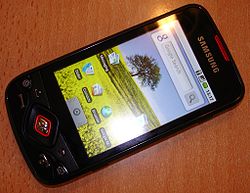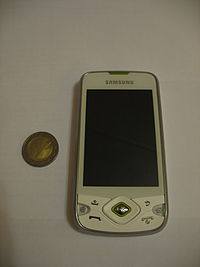 | |
| Manufacturer | Samsung |
|---|---|
| First released | November 2009 |
| Availability by region | November 2009 |
| Successor | Samsung Galaxy 3 |
| Related | Samsung Galaxy (original) |
| Compatible networks | HSDPA (3G) 900/2100, Quad band GSM / GPRS / EDGE GSM 850, GSM 900, GSM 1800, GSM 1900 |
| Form factor | Slate |
| Dimensions | 115 mm (4.5 in) H 57 mm (2.2 in) W 13.2 mm (0.52 in) D |
| Weight | 124 g |
| Operating system | Original: Android 1.5 "Cupcake" Current: Android 2.1 "Eclair" |
| CPU | Samsung S3C6410 800 MHz |
| GPU | FIMG 3DSE |
| Memory | 256 MB RAM |
| Storage | 512 MB flash, 180 MB user available |
| Removable storage | MicroSD support for up to 32 GB |
| Battery | Li-Ion (1500 mAh) |
| Rear camera | 3.2 Megapixels |
| Display | 320×480 px, 3.2 in (81 mm), HVGA, 65,536 color LCD at 180 pixels per inch (ppi) |
| Connectivity | USB 2.0, Bluetooth 2.1, Wi-Fi 802.11 b/g, GPS |
| Data inputs | Touch Screen (capacitive) |
The Samsung Galaxy Spica, also known as Samsung Spica, Samsung GT-I5700, Samsung Galaxy Lite [1] and Samsung Galaxy Portal, is a smartphone manufactured by Samsung and introduced in 2009 that uses the open source Android operating system. The phone is positioned below the original Samsung Galaxy. Even though some of its features like the camera resolution, storage and data connection speeds are lower than the i7500, its processor's clock speed is much higher at 800 MHz. It is succeeded by the Samsung Galaxy 3.
